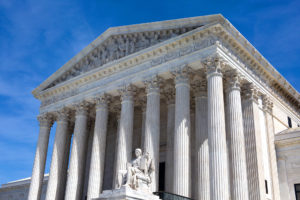 From time to time over the past several years, I have written in this blog about various issues arising under the takings clause of the U.S. Constitution. Despite the apparent simplicity of this provision, which prohibits the government from taking private property for public use without just compensation, controversies regularly flare up regarding the question of indirect takings resulting from governmental limits on real estate development. These clashes reflect a basic tension in our American legal tradition between land use regulation and real property rights.
From time to time over the past several years, I have written in this blog about various issues arising under the takings clause of the U.S. Constitution. Despite the apparent simplicity of this provision, which prohibits the government from taking private property for public use without just compensation, controversies regularly flare up regarding the question of indirect takings resulting from governmental limits on real estate development. These clashes reflect a basic tension in our American legal tradition between land use regulation and real property rights.
One longstanding point of contention has been the limits placed by the U.S. Supreme Court on property owners’ access to the federal courts to assert claims of state and local regulatory takings. As set forth by the Court in the 1985 case of Williamson County Regional Planning Comm’n v. Hamilton Bank of Johnson City, the rule has been that plaintiffs seeking to bring such claims in federal court must first seek relief in the state courts. This past June, however, in the case of Knick v. Township of Scott, a 5-4 majority of the Court overruled that earlier precedent in a decision fraught with potentially far-reaching implications, not only for regulatory takings lawsuits in federal court, but also for the future of land use regulation in general.
The facts of the Knick case are straightforward: Rose Mary Knick is the owner of a 90-acre parcel of land in Scott Township that contains her home, an open area for her horses and other livestock to graze, and a small cemetery of a type commonly found in that area, in which her neighbors’ ancestors are buried. The township passed an ordinance in 2012 requiring cemeteries to be open to the public during daylight hours. In 2013, the township cited Ms. Knick in 2013 for violating that ordinance after observing grave markers on her property.
Responding to Ms. Knick’s state court lawsuit seeking declaratory and injunctive relief with respect to that ordinance, the township withdrew the ordinance and stayed enforcement of the citation pending a decision by the state court. The state court would not rule on Ms. Knick’s case, however, because she could not show the irreparable harm necessary to obtain relief without the township seeking to enforce the citation. Ms. Knick then filed suit in federal court, claiming that a taking had occurred in violation of the Fifth Amendment; the trial court dismissed her claim in reliance on Williamson County, and the court of appeal affirmed the dismissal. At that point, Ms. Knick sought review by the Supreme Court.
Writing for the 5-4 majority, Justice John Roberts noted that Ms. Knick had been placed in an untenable position under the authority laid down in the Williamson County case for the proposition that a plaintiff pursuing a regulatory takings claim must first seek relief from the state courts before filing suit in federal court. The flaw in this decision, as Justice Roberts pointed out, did not become clear until the Supreme Court’s 2005 ruling in the case of San Remo Hotel, L. P. v. City and County of San Francisco, which held that the Constitution’s “full faith and credit” clause precluded federal courts from deciding matters that had already been resolved in the state courts. Justice Roberts summed up the problem in this manner:
The takings plaintiff thus finds himself in a Catch-22: He cannot go to federal court without going to state court first; but if he goes to state court and loses, his claim will be barred in federal court. The federal claim dies aborning.”
In addition, Justice Roberts stated that the Williamson County case placed an undue burden on property owners’ exercise of their constitutional rights in the federal courts by requiring them to first pursue their state court remedies for regulatory takings of their property. He concluded that such takings occur and give rise to a right to sue in federal court at the time that the regulation depriving the property owner of his rights is adopted, employing several pointed analogies:
A later payment of compensation may remedy the constitutional violation that occurred at the time of the taking, but that does not mean the violation never took place. The violation is the only reason compensation was owed in the first place. A bank robber might give the loot back, but he still robbed the bank. The availability of a subsequent compensation remedy for a taking without compensation no more means there never was a constitutional violation in the first place than the availability of a damages action renders negligent conduct compliant with the duty of care.”
Writing in sharp dissent, Justice Elena Kagan maintained that the effect of Justice Roberts’s majority opinion was much broader than to simply overrule Williamson County:
[I]ts decision rejects far more than that single case. Williamson County was rooted in an understanding of the Fifth Amendment’s Takings Clause stretching back to the late 1800s. On that view, a government could take property so long as it provided a reliable mechanism to pay just compensation, even if the payment came after the fact. No longer. The majority today holds, in conflict with precedent after precedent, that a government violates the Constitution whenever it takes property without advance compensation—no matter how good its commitment to pay. That conclusion has no basis in the Takings Clause….And it transgresses all usual principles of stare decisis.”
Justice Kagan also asserted that the Court’s decision in this case would have two significant additional negative impacts. First, rejecting the bank robber analogy, Justice Kagan noted that, by declaring such land use regulations to be in violation of the takings clause by depriving the property owner of rights at the time the regulation is adopted, it “will inevitably turn even well-meaning government officials into lawbreakers.” Second, despite the fact that the Supreme Court has previously ruled that the regulation of land use is “perhaps the quintessential state activity,” Justice Kagan points out that “the majority’s ruling channels to federal courts a (potentially massive) set of cases that more properly belongs, at least in the first instance, in state courts—where Williamson County put them.”
In reading the arguments being made by the majority and the dissent, this ruling may have significant impacts on all types of land use laws, from energy regulations to regional planning to public benefit easements and beyond. As I have previously noted in this blog, there has been a great deal of litigation at the Supreme Court level over exactions imposed on property development. With the Court’s ruling in the Knick case, we may see an even greater amount of regulatory takings litigation being brought in the federal courts. Further, the fact that Knick has held that an actionable regulatory taking occurs when a law is enacted could act to suppress state and local lawmakers from adopting ordinances that, while perhaps consistent with public policy, may be viewed to interfere with rights that may now be enforced through direct access to federal courts.
Knick v. Township of Scott, 588 U. S. ___ (2019) may be found here.



